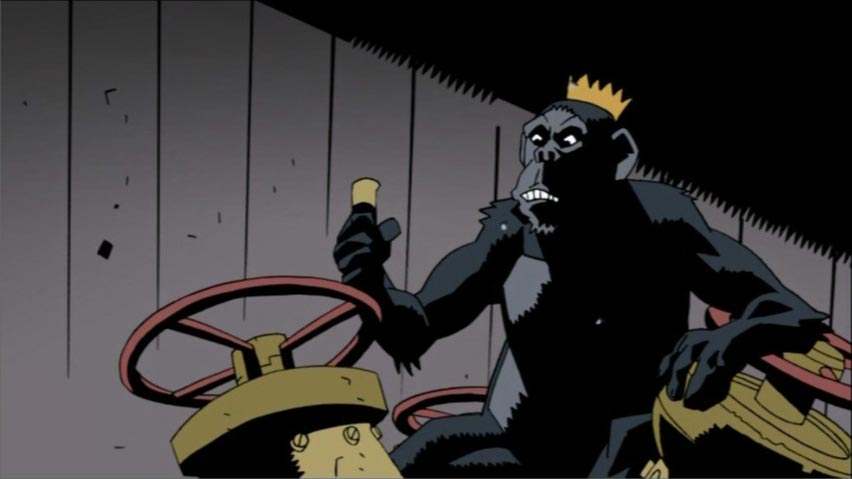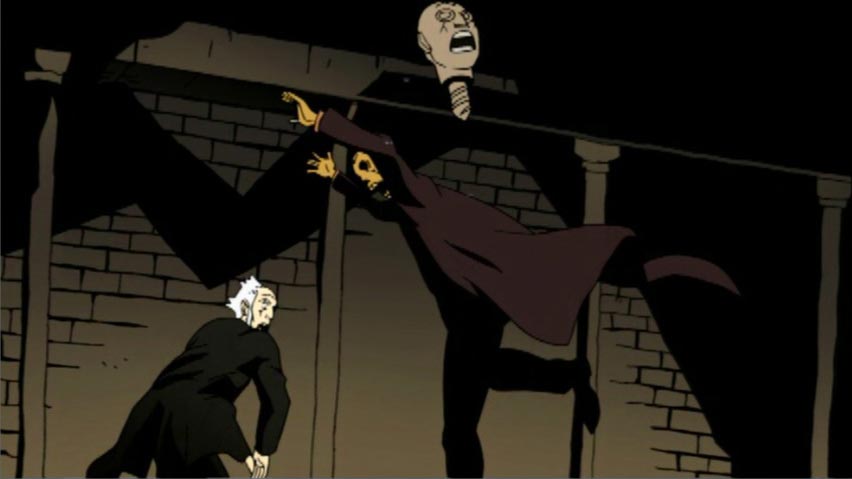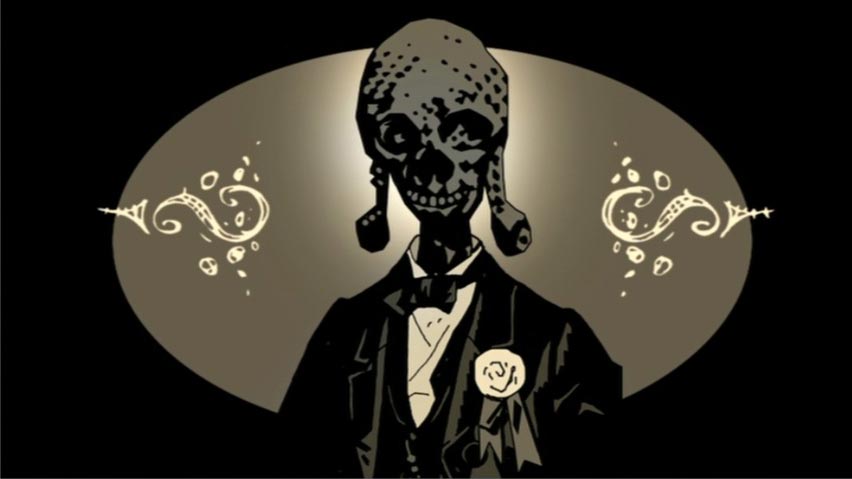My fellow members of the Order of the Science Scouts of Exceptional Repute and Above Average Physique:

This is worth watching. For those of you who still watch television in a more traditional fashion, you might still be able to catch it on a somewhat bigger screen on whatever local public broadcasting station carries NOVA. For those of you for whom video is too damned slow, there are transcripts that seem to cover all the bases.
For that matter, this is a good read, too. Keep reminding yourself that it was written by a Santorum nominee confirmed personally by GWB. Sometimes it’s tough to tell.
Yes, it’s been two years since the ruling. But it’s only been a week or so since the release of this documentary. For that matter, it’s been twenty years since the ruling that said creationism isn’t science and has no business being taught in science classes. Except—and this is an important except—as an example of what science isn’t. Because obviously some people still don’t get it. Like the Discovery Institute. And the Thomas More Law Center. And just over fifty percent of your fellow voters, at minimum.
In any case, two years is not a lot of time. Apparently TWENTY years is not a lot of time.
The show is very heartening to those of us who worry about what religious fundamentalists want to have taught as science. The show is very discouraging because it reveals that certain things we hope can’t happen in the USA can happen. And probably will happen, eventually. And did happen, two years ago. Briefly.
The fact that science is this vulnerable makes me wonder what happens when the next subject under fire for not presenting the “Christian Alternative Viewpoint” is world history. or US history.
Do you think there can’t be a time when our children’s classes have a political officer or a party official approving textbooks or sitting in to make sure what’s being taught is in alignment with the views of the party? Think again.
[*]
 Another comic from Mike Mignola makes it to the
Another comic from Mike Mignola makes it to the big small screen. It should have been the big screen, but no one’s going to spend more time driving to the cinema than they’ll spend watching the feature. Hell, the previews last longer than 22 minutes these days. Regardless, it’s a big shame that most of you will never see this.
Mike Mignola is the writer/artist that brought us the fabulously successful Hellboy. Anyone who actually saw the comic book will recognize the signature style and palette in the animated The Amazing Screw-On Head–as well as the trademark steampunk/sf/horror themes. Those themes are rendered in The Amazing Screw-On Head with no punches pulled.
 Those of you who paid attention in US History class will remember that President Abraham Lincoln started the Secret Service, along with setting a wonderful precedent for suspending habeas corpus during war-time and inventing other “special rules” for preserving National Security — which is just like a Republican.
Those of you who paid attention in US History class will remember that President Abraham Lincoln started the Secret Service, along with setting a wonderful precedent for suspending habeas corpus during war-time and inventing other “special rules” for preserving National Security — which is just like a Republican.
[I don’t know who’s reading this that I’d have to say this to, but I’m not one of those Confederate Battle-Flag wielding loonies we get out in the woods around here. I don’t have much use for slaves. Or bigots. But weaving the carpet that all kinds of governmental travesties get swept under was a BIG mistake, and I don’t appreciate it. I don’t know Abraham Lincoln personally, but I have the feeling that if he knew what Grant, Harding, Nixon, and Bush Jr. were going to be bringing to the table, he would have been a hell of a lot more careful.]
 In any case, Screw-On Head is a hero who, like a Secret Service agent, reports directly to Lincoln and helps keep the (fragmented) country safe from supernatural and advanced (heh) technological assault–particularly from his ex-manservant-turned-low-budget-immortal Emperor Zombie.
In any case, Screw-On Head is a hero who, like a Secret Service agent, reports directly to Lincoln and helps keep the (fragmented) country safe from supernatural and advanced (heh) technological assault–particularly from his ex-manservant-turned-low-budget-immortal Emperor Zombie.
Screw-On Head is inherently ludicrous, starting with his anatomy–based on interchangeable mechanical bodies and a metal-encased (possibly robotic) head with a threaded neck–and moving up through his G.-Gordon-Liddy-as-a-Killer-Boy-Scout modus operandi. However, it’s Emperor Zombie’s educated and joyfully glib banter that steals the show. Again and again and again. It’s freakin’ hysterical.
 It’s easy to cast Screw-On Head as the rudimentary beginnings of The Bureau for Paranormal Research and Defense from Hellboy‘s backstory. That notwithstanding, Mignola say’s he’s completely done with Screw-On Head and has no dreams of adding more tales to the storyline. Apparently he got all the gags he wanted to perpetrate out of his system in this story. Those who want more will have to go find Will Smith/Kevin Klein/Kenneth Brannaugh’s Wild Wild West movie, I guess. (If you rent that with your credit card, the Department of Homeland Security is bound to put you on some list or other. I heartily recommend you use cash for anonymity purposes. There’s no way you want that rental on your permanent record.)
It’s easy to cast Screw-On Head as the rudimentary beginnings of The Bureau for Paranormal Research and Defense from Hellboy‘s backstory. That notwithstanding, Mignola say’s he’s completely done with Screw-On Head and has no dreams of adding more tales to the storyline. Apparently he got all the gags he wanted to perpetrate out of his system in this story. Those who want more will have to go find Will Smith/Kevin Klein/Kenneth Brannaugh’s Wild Wild West movie, I guess. (If you rent that with your credit card, the Department of Homeland Security is bound to put you on some list or other. I heartily recommend you use cash for anonymity purposes. There’s no way you want that rental on your permanent record.)
 I don’t know where you’ll have to go to find a copy of Amazing Screw-On Head. I live in Atlanta, and I found a copy at Videodrome, on North Avenue and North Highland on the border between Little Five Points and Virginia Highlands, East of Midtown. If you have a favorite independent rental place, I recommend checking there.
I don’t know where you’ll have to go to find a copy of Amazing Screw-On Head. I live in Atlanta, and I found a copy at Videodrome, on North Avenue and North Highland on the border between Little Five Points and Virginia Highlands, East of Midtown. If you have a favorite independent rental place, I recommend checking there.
Better yet, buy yourself a copy. You’ll probably stop re-watching it shortly after you’ve completely memorized the dialog and run out of friends and relatives you haven’t already forced to watch it two or three times. So it goes. When you’re done with your copy, be a trooper and mail it to me, and I’ll make sure it finds a good home.
 In the meanwhile, feel free to chop up those MP3s I linked above so you can make custom ringtones for your phone. I can’t think of a better way to advertise for an amazing movie than having friends and strangers ask you “What the fuck was that?!” every time your phone rings.
In the meanwhile, feel free to chop up those MP3s I linked above so you can make custom ringtones for your phone. I can’t think of a better way to advertise for an amazing movie than having friends and strangers ask you “What the fuck was that?!” every time your phone rings.
[*]
Interesting things happen in people’s heads when you tell them you’re a fan of Chuck Palahniuk’s work, and almost none of them are good. Even if you’re talking to another Palahniuk fan.
Yeah, there’s violence and gross stuff in his books. No more though than I recall from stories we’d tell one another around the cafeteria tables in high school, trying to score points by making each other spit food out of our mouths or snort it out of our noses or–a rare bonus–put one of our comrades off his or her feed so that whoever had stomach enough afterwards could finish the abandoned meal. It’s possible I may be speaking here from a somewhat desensitized viewpoint. I understand this. But the point I’m making is that a bunch of hobbyist amateurs were just as good at the gross-out.
Saying you’re a Palahniuk fan, though, isn’t necessarily saying that you’re a fan of the violence and gore and downright disgusting elements that makes reading a Palahniuk novel pretty much the same as taking your chances tipping back a box of Bertie Bott’s Every Flavor Beans. It’s not just about the gross-out.
One of Palahniuk’s recurring themes is that of people in search of real experiences instead of filtered, prettified, Photoshopped, video-edited, recorded, and packaged experiences. People who think that, even if there is nothing new under the sun, they should at least experience the sun for themselves. This was a major theme in Fight Club and a minor one in Rant. Critics claim a bit of recycling is going on here, but speaking as an author, I know what it’s like to not get everything you have to say all out of you in one go. Fight Clubs and Party Crashers might have similar motivations, but there’s nothing much in either one of those you won’t find in people who go to live concerts or raves or sporting events or even church–depending on the church, and it’s pretty much the reason for taking any drug you might be fond of: personal experience and a shared high. That’s not a cool new thing he’s invented. He’s giving you a look at a really old phenomenon, but he’s putting it in a new package so you’ll see it in a fresh way.
I like Palahniuk because I like the way he tells stories. I also like the stories he chooses to tell. But primarily it’s the first thing.
It’s hard to tell a story. You require an enormous amount of complicity from your audience. You can’t just throw words at someone and hope to keep them interested and involved. You have to help your audience achieve some kind of state where your words create an experience for them–a filtered, prettified, Photoshopped, video-edited, recorded, and packaged experience, but an experience nonetheless.
A quick aside: if you think Palahniuk is preaching that people should have their own high-impact experiences instead of dealing strictly in the prepackaged, then understand you’re accusing an author of preaching against books. Accusing a storyteller of preaching against stories. Whatever. And if you think Palahniuk doesn’t get the irony of that, then ask him why his latest written work is subtitled An Oral Biography of Buster Casey. Oral biography. Written. Get it?
Anyway. It’s hard to tell a story. It’s hard to get people’s attention long enough to say anything. It’s even harder to get them to pay you for the privilege. You can go all the way back to the first written stories to watch the struggle. The first oral stories, even. Rhyme and meter and repetition weren’t there for the first epic stories just to help the storytellers remember the words. Rhythm, in particular, is essential for putting your audience into a trance so you can dump images into their hypnotized heads. Music and song were the first effective storytelling tools. Because of that trance thing.
After verse, authors struggled a bit. The birth of the novel was a difficult one. Some of the original ideas included presenting a story as a stack of correspondence. Letters and postcards. Authors still resort to this regardless of how poorly it works. Because not all of your correspondents can be, themselves, storytellers. When they are, the readers wonder why, and it breaks things. Like sometimes we’re forced to wonder why everyone in movies is gorgeous. It’s tricky.
Palahniuk tells good stories and he tells them well. Frequently he makes his characters (believably) storytellers and he makes them tell their stories. I dig that. It almost always works. Even though it’s tricky.
Part of the trick is that he has a grasp of rhythm. On many different scales. And that’s really tricky when you’re working with written stuff. The emphasis on syllables, the sounds letters make, the silences and beats generated by punctuation–making your readers breathe only when you want them to so you can enforce the mood and tone–this is fucking mind control and it’s an old science. One of Palahniuk’s characters in Rant is more than willing to teach you some of it if you care to take a few notes.
With written word you even have to pay attention to the shapes of the letters. Curves and lines and sticky-uppy and sticky-downy bits–as your eyes saccade across the line of text, the rhythm of the shapes has just as much of an impact as anything else, which is why choice of typeface is an important factor in book design. Or can be, depending on what’s being said. You choose words sometimes based on how they look as well as how they sound, and for how they can sometimes be mistaken for other words if you’re in a hurry and not paying attention. Well. At least you can if you feel like doing the work. If it seems like it’s important for that particular piece.
My point is Palahniuk is good at this stuff. I really can’t tell if he does much of it consciously, but I suspect he does. It’s not necessary for a writer to be conscious of what he’s doing in the very same way that a dancer doesn’t have to be conscious of every individual muscle movement in order to be graceful. But conscious or not, intentional or not, he’s good at it, and I appreciate it. He sure as hell can filter, prettify, Photoshop, video-edit, record, and package an experience–intense, personal, and shared, just like church. Or a drug. Or live music. It’s tricky.
[*]
…I’m having enough trouble getting XP drivers that are happy with my 2GHz Intel Centrino Core Duo. It’s a Dell notebook, for Chrissakes. Bluescreens from video drivers? Why did you sell it if it wasn’t ready? It’s been months and I’m fairly religious about updates and patches….
In any case, I haven’t heard many good things about Vista yet. The bad things I’ve heard include “it’s slower” and “some shit doesn’t work”. That’s bad, since I use a lot of stuff (i.e., “shit”) that might not be rewritten for Vista anytime soon.
Instead, I use:
- Otaku Software’s TopDesk 1.4.2 ($15, free 30-day trial)
- Stardock WindowBlinds 5.01 ($20, not just eye-candy. Has a few extra controls for windows. Free version sucks quite a bit. Love that per-pixel alpha blend.)
- R2d2 Software’s Virtual Desktop Toolbox 2.72 (free, keeps me from paying for whole $50 Stardock Object Desktop, which includes virtual screens, WindowBlinds, and a thousand other things)
So hey, $35US for Vista-like eye candy without the software crashes and slowdown? Extra usability, too? And, for you lucky goobs with extra monitors, all of the above supports multiple monitors.
And since VMWARE server is now free also (Yes, I’ve enabled the virtualization stuff in BIOS), I can flip over to a virtual screen where a VNC session is open to my free CentOS 4.4 install (XFCE, why do you ask?), where I have access to my true hack-o-matic tools.
Yeah, sure, whatever. If I can’t smell my CPU sweating, it’s not working.
[*]
I’m a fan of labyrinths. I’ve walked through only a few of the more symbolic kind, but I like the idea that there could be a piece of geography deliberately designed for me to get lost in. I look forward to visiting several in my lifetime and, I hope, finding my way out again. I’m certainly well experienced with a number of unintentional labyrinths, such as the Hilton Rye Town, of Rye Brook, NY, and the streets of Atlanta, girdled by the circular dimensional rift that is I-285, around which it is possible to do laps (refueling two or three times even) in the assumption that you’re actually going somewhere.
Keep in mind that a true labyrinth is not just a maze. A labyrinth is a maze that is life-threatening. A labyrinth has a guardian monster, and it’s impossible to have a labyrinth that doesn’t also involve the motif of people being sacrificed to the monster inside. Without those things you merely have a walk in the park that lasts a little longer than you had originally intended.
(I-285 certainly counts. It’s life-threatening. In fact, everyone who uses it is aware that it takes lives on a weekly if not daily basis. Everyone also hopes that someone else is going to be the blood sacrifice to the dark gods that keep the system running.)
Pan’s labyrinth is a fictional labyrinth, a species of labyrinth of which I am particularly a connoisseur. I’m close, personal friends of Theseus and the Minotaur in many of their incarnations. I read and reread Jorge Luis Borges, who is constitutionally unable to write a story that doesn’t use either the word or the metaphor. I’ve read Mark Z. Danielewski’s House of Leaves more than twice. (For that book, it’s easy to lose count after two.) Certainly David Foster Wallace’s Infinite Jest counts, though he may not have had the concept of labyrinths in mind as he was writing. Ditto for a certain work from Robert Anton Wilson and Robert Shea, and also a certain famous work from James Joyce. For visual media, there’s the movie Labyrinth from Jim Henson, and then a huge number less blatant that are too numerous to mention.
I should note that the name “Pan’s labyrinth” is a bit of a misnomer–but one I’ll continue using throughout the review just to avoid confusion. The title of the movie in which it features is El Laberinto del Fauno, or “The Labyrinth of the Faun”. There’s an association in Greek mythology between the horned nature god Pan and fauns and satyrs, but the faun featured is not any top-ranking god but an emissary of a fairy king. I’m guessing the name got tweaked because “stupid Americans” were thought more likely to recognize Pan as some guy with horns than “faun”, and the synonym “satyr”, while somewhat more recognizable to a US audience, conjures unsavory associations for an R-rated movie that features a prepubescent girl in the leading role.
Anyway.
Physical characteristics
As fictional labyrinths go it’s not as extensive as the one depicted in Jim Henson’s movie.
Pan’s labyrinth is constructed of stone, about ten feet high and maybe thirty or forty yards square. The stone is uniformly dark and coarse and crumbling a bit, another firm hint that it is a labyrinth of a certain age. The corridors in the maze are rectilinear and approximately ten feet wide, which is perfect for the typical Dungeons & Dragons® dungeon maps on the blue-lined grid paper that was ubiquitous back in grade school.
Pan’s labyrinth is spatially situated in the Spanish countryside and is temporally located a few years after the Spanish Civil War, in 1944. We are given the impression that the labyrinth is many hundreds of years older than that, but it is, after all, just a set in a movie.
It’s not giving anything away to say that the labyrinth is also located in a kind of fairy realm and seems to be the passage between there and the mundane world.
Sensoria
Still contrasting Pan’s labyrinth with David Bowie’s from the Henson film, Pan’s is certainly grimmer, appearing as it does in a movie that is not intended to be viewed by a juvenile audience. We only see it lit in fading greens and yellows or the starker black and white of a nighttime visit.
Also the labyrinth seems to generate its own heat, which I gathered from the fact that the old stone mill house that was being used as a residence nearby had fires going in the bedroom fireplaces, yet a young girl, soaking wet from rain, wasn’t shivering or otherwise apparently cold during repeated trips through the maze in the middle of the fucking night.
Market data
Access to this labyrinth seemed to be free of charge to residents at the old mill house and the attendant military company. I assume access would be denied to anyone not cleared by representatives of Francisco Franco’s military forces, making any curiosity about price of admission to non-residents pretty much moot.
So far I’ve been unable to research the costs of having a labyrinth like this made during the era it was supposedly constructed. A couple hundred thousand fairy slaves could probably get it done in a matter of an hour or two and you’d only have to pay them in pollen. I also have no data on purchasing the land (with the already constructed labyrinth) in 1944 pesetas. Presumably you could always have the land donated to the fascist cause by a loyal sympathizer or, with a company of military forces, take it from someone you declare to be a socialist or anarchist rebel, either of which would greatly reduce the amount to be paid.
Overall impact
My evaluation of labyrinths is based on two main factors: 1) How cool it would be to wander around in it (properly defended from the resident monster, of course) and 2) how useful it would be for disposing of my enemies by sentencing them to wander around in it until they get eaten.
If I had a bit of land to work with–something larger than my backyard, for instance–Pan’s labyrinth would be a wonderfully atmospheric addition. Decor-wise, it wins. Also, it is not so inconveniently large that I would need my own fairy kingdom to keep it in, as I’d opt to own just the portion that extends into the mundane world. Weighing in on both factors, the main guardian of the labyrinth seemed quite competent to do in any mortal of his choosing, while also being clever enough to negotiate with should the need arise–a big step up from the Minotaur. Or minotaur. Or
minotaur. Depending on which edition of Danielewski’s book you ended up with.Viewers of the movie also got a brief hint that the maze could be reconfigured at whim, which is a great defense against clever bastards with string or breadcrumbs. Another definite plus.
There is one definite minus, however. The labyrinth had no roof of any kind and the walls looked very climbable, a potential security hole that could allow a moderately agile cheater to bypass the thing entirely. I saw no evidence that there were any considerations to counter this problem. There may have been, granted, but without having seen any, I’m forced to assume the worst. And a labyrinth that was easily an A + drops to a firm middle-range B. Still quite worthwhile.
Also, the movie was really good.
[*]
PS: Your one-line bonus review
“Early adopters” are great for testing the water. I suggest you find yourself one.
[.]
The subject of today’s review is … cupcakes. Not any particular recipe or any particular chef’s rendition. Just cupcakes. Mmmmm … cupcakes.
If you have a Western upbringing, you’ve seen them I’m sure. For everyone else, cupcakes are cake-like, but not cakes. They typically don’t have layers, yet they’re taller than a sheet cake. The texture is more cake-ish than the muffins they resemble, but they are less likely to be allowed to mushroom out of their containers and are also usually iced or frosted. They are never frosted on the sides. Cups don’t feature at all unless you go for the stretch that the little accordioned paper condom that keeps them from sticking to the muffin tin they’re baked in could possibly be called a cup. They are cup-sized, however–anywhere from demitasse up to soup mug.
Almost any form of cake can have a cupcake analog except coffee cakes and Bundt cakes. Just face it. Cupcake variants of coffee cakes are muffins. And Bundt cupcakes are fragile-ish flat-bottomed donuts. You people trying the fancy stuff aren’t fooling anybody.
Physical characteristics
Cupcakes are usually served at room temperature. Their bottoms are like an oily, crumbly sponge and their tops are coated with a sticky paste. Under approximately fifty pounds of pressure, they squash completely flat and stay that way. If you’re the type to distinguish the quality of a dessert by whether it sticks to the wall when you throw it hard, then it rates somewhere between pudding and brownies. For benchmark purposes, cupcake weights are measured in ounces or grams, at least with respect to more successful recipes.
Sensoria
The texture associated with cupcakes I’ve already described above. Being a dessert, though, the most vital component of the cupcake experience is flavor, followed possibly by aroma. Texture remains important, though. If your cupcake is unexpectedly crunchy or slimy or chewy or powdery, it could negatively expect your enjoyment.
Flavors tend to follow the dessert/candy standards, typically with less emphasis on fruit flavors that you would have with, say, hard candies or gelatins. Vanillas, chocolates, and dairy-derived flavorings (except for cheeses) are popular. Fruits and nuts are largely accents.
While I am fond of fruits and nuts, artificial fruit and nut flavorings are frequently nothing short of heinous. I studied organic chemistry in college and I recall having to synthesize the ester that is the principal component of artificial banana flavoring. It’s tricky. And now that I know what that chemical-tasting taint is that most artificial flavorings have, I’m not interested in consuming it voluntarily. Like with any sort of cake or pastry or dessert, if you’re going to have a flavoring added, it should be distilled from the actual substance–whether it’s vanilla or banana or chocolate or pork. Artificial is not the way to go. It will only end in tears unless you are twelve years old or younger. If you are prepubescent you almost certainly have some mysterious immunity to heinous artificial flavorings. Enjoy it while you can. It makes your desserts much cheaper. Which brings us to…
Market data
Cupcakes are, if you are purchasing them for personal consumption, a far better option than purchasing a whole cake, whether sheet or layer. A whole full-sized cake can cost plenty of money–up to tens of thousands of dollars for some cakes. A whole cupcake has a much more reasonable price cap. Also, if you get a slice of normal cake, there’s always that nagging knowledge that there is more cake that you could have eaten. Only freaks eat part of a cupcake, so when you’re done, you’re done. The temptation to consume more is greatly reduced, so your costs aren’t likely to change unexpectedly.
If you are making cupcakes, then you are probably making more than one–unless your oven is one of those designed to cook things with the heat of an incandescent light bulb. In any case, the cost of making six to ten cupcakes is equivalent to making a two-layer nine-inch cake or a 9″ x 13″ sheet cake, whether using a mix or working from scratch. All told, your buy-in is between a couple of bucks and maybe up to twenty to thirty US dollars if you insist on premium ingredients and flavorings.
Cupcakes do not age well and thus do not make good long-term investments.
Overall Impact
Cupcakes are better than dental surgery, yet not as desirable as a winning lottery ticket worth thousands of dollars. Given such an open ended scale in either direction, cupcakes as a stand-alone concept wouldn’t earn much more than a C+. Rated strictly against other desserts, however, they score a bit higher. They come in easily regulated doses. They don’t require the risk of wielding sharp implements to serve them. They are frequently eaten using no utensils or tableware at all, and, as such, don’t require that you be seated at the time. And they are available in a wide range of flavors. On the negative side, trying to preserve the frosting on top makes them difficult to transport, and that’s a definite minus. There is also usually a nasty paper wrapper (the aforementioned “cup”) that needs discarding afterwards, but that’s not really worth losing any points. If it weren’t for the tendencies towards artificial flavorings and the difficulty of transport, they’d certainly get an A+, but docking them twice, we’re left with a firm A-.
[*]
PS: Your bonus one-line review
Eyebrows: A wonderful invention for keeping sweat out of your eyes. The painted-on ones are no good for that. Accept no substitutes.
[.]
As a long-time connoisseur of breathing, I’m uniquely qualified to give my viewpoint. My lungs and attendant respiratory plumbing, while not those of an athlete or meditator or other kind of breathing specialist, closely resemble those of the average consumer of air. Also, over my multiple decades of breathing I’ve obtained a broad range of experience air-wise and have paid careful attention to my breathing experiences. This allows me to tender opinions and judgments relevant to the largest segment of the reading, air-consuming market.
Category: Physical characteristics
Reviewing air based on physical characteristics is kind of like reviewing wine based on its ability to fill a glass and keep a level surface as it sits there. Does it fill the glass from the bottom to its meniscus evenly, without leaving any unsightly gaps? Is it suitably liquid and not in any way solid or gaseous or plasmid? What’s its peak frequency of transmitted light? Specific heat? Who the hell cares! What you want to know is will you gag when you drink it and will it give you a buzz that’s worth the price of the bottle and tomorrow’s hangover. (If you were wine connoisseurs, even amateur ones, you might be interested in color and bouquet and finish and suchlike, but I’m sure I know my audience here. Qualities like those I just listed are for wine collectors, not wine drinkers. People like that would spit it back into the bottle and sip it again later if that would work. Thank To Whom It May Concern that it doesn’t. Especially if they ever invite you over for dinner.)
However, there are some physical characteristics of air that are relevant to the air consumer versus the air collector. These are things like temperature, density, and composition–including oxygen content and humidity. Does it effectively deliver oxygen and dissolve the carbon dioxide you try to give it? These things are extraordinarily relevant to one’s enjoyment of a lungful but are only worth brief discussion.
Category: Sensoria
The breathing experience is not just limited to brute physical characteristics. Under the subcategory of composition, strictly speaking, we have aroma, flavor, and/or particulate materials that contribute to the digestion of the air and the enjoyment of it. Much can be said about the sensory impact of a lungful. As a reader of reviews, you are most likely looking for an informed evaluation of the subjective experience and here is where most of those details fall.
Category: Market data
This is simply pricing and availability, with modifications as necessary by region. For deeper market investment information such as air futures please look elsewhere.
Category: Overall impact
We’re still talking air here. There really aren’t an awful lot of details that are relevant to the average consumer’s interest other than the ones above. I understand, however, that some readers won’t want to give a lot of time to a lot of hot air about air, so this is where the more impatient of you should skip to for the punchline. I don’t mind. Seriously.
Now onto the current lungful.
I obtained this air at the juncture of my backdoor (which is in my kitchen) and the outside landing, roughly ten or twelve feet above ground-level with respect to my backyard. This includes the distance from where I was standing to my nose, which is only fair. Sometimes I experience air from a sitting or prone position, which is occasionally relevant. The wind was blowing in through the door, so this lungful contains many more outdoor elements than kitchen taints. For geographical and seasonal data, you should know that my house is in a forty-year-old neighborhood, lightly wooded, in unincorporated DeKalb County, Georgia, on the outskirts of Atlanta, perhaps a thousand yards from Sunday morning traffic on I-285. The time obtained is January 28, 2007, around 10:30 AM EST.
Physical characteristics
Temperature: Cool, but not icy.
Composition: Low humidity, but not abysmally so. It had rained last night, but winds have been strong and are picking up speed, carrying some of the moisture away with it. Decent oxygen content, as is common with cooler air. No detectable levels of macroscopic particulate content like dust or pollen.
Sensoria
The principal aromatic characteristic of this lungful is a side-effect of owning three dogs and a fenced-in backyard. As most dog-owners know, the size of the odor of a dog is completely independent of the size of the dog itself, which is just the same as saying a little dog goes a long way. However, the dogginess and doggy-by-productness of this lungful aren’t in any way overwhelming.
The oddest aromatic component of the current lungful is the essence of fish, which is tough to explain for this locale. It wasn’t the odor of cooking fish, but of live (or recently live) fish.
This fishy odor came nowhere near my personal low point of air-consumption experience: a lungful obtained interior to the Tokyo fishmarket during a warm springtime afternoon in 1973, where the other dominant aromatic component was diesel exhaust–an overall “F-” experience if there ever was one that was not at the same time also poisonously lethal.
Also in the definitely-present-yet-not-cloyingly-so category are the scents of damp earth and damp greenery, somewhat at odds with the dryness of the air and the lateness of the season. Plenty of the tress and shrubbery haven’t given up their leaves yet, but they’ll probably think about it more seriously tonight when it gets into the low twenties.
Market data
This air, like many lungfuls, was obtained free-of-charge. Right now, should I desire it, I could go obtain another one almost exactly like it. For yourself, however, you should consider the cost of travel to my house, whether you could get here in time to experience a similar lungful, and whether you’re in the category of acquaintance I would allow admittance to my house or yard without charging admission. But hey, it’s free for me–ignoring mortgage and maintenance costs of being allowed to live here, which I calculate to be roughly $.04US per minute, or a penny for every five breaths.
Overall impact
I hesitate to use a term as worn as “crisp”, but it fits. I’m sure that’s fine, though, for people who enjoy chugging whatever it is that’s their favorite as much as–or more than–trying something exotic. Crisp is what you can expect for this time of year in this region, and it beats the hell out of the “sharp” stuff you’ll get from points farther north today and the warm wet sponge you try to get oxygen out of here in the summer. Basically this lungful gets a B- without even trying even considering the dogginess. Points were taken off for the bizarreness of the fish taint, even though it wasn’t as harsh as it could have been. Overall: satisfactory, in every connotation of the word.
[*]
PS: Your one-line bonus review
Diet Berries & Cream Dr Pepper: Flavorwise, a fistfight in a can. Think twice. Check your insurance.
[.]
Categories
Archives
- January 2018
- January 2016
- June 2015
- May 2014
- January 2014
- October 2013
- June 2013
- April 2013
- March 2013
- February 2013
- November 2012
- October 2012
- September 2012
- August 2012
- July 2012
- June 2012
- May 2012
- April 2012
- March 2012
- February 2012
- January 2012
- December 2011
- November 2011
- October 2011
- September 2011
- August 2011
- July 2011
- June 2011
- May 2011
- April 2011
- March 2011
- February 2011
- January 2011
- December 2010
- November 2010
- October 2010
- September 2010
- August 2010
- July 2010
- June 2010
- May 2010
- April 2010
- March 2010
- February 2010
- January 2010
- December 2009
- November 2009
- October 2009
- September 2009
- August 2009
- July 2009
- May 2009
- March 2009
- February 2009
- December 2008
- November 2008
- October 2008
- September 2008
- August 2008
- July 2008
- June 2008
- May 2008
- April 2008
- March 2008
- February 2008
- January 2008
- December 2007
- November 2007
- October 2007
- September 2007
- August 2007
- July 2007
- June 2007
- May 2007
- April 2007
- March 2007
- February 2007
- January 2007
- October 2006
- September 2006
- July 2006
- June 2006
- May 2006
- April 2006
- March 2006
This One Time
-
This One Time, 26
This one time I was sitting in a old wooden boat that wouldn’t have been allowed to do time as a dinghy where I used to work, not that there was any ocean within a thousand miles of here. It was witch’s-navel cold, only we didn’t used to say “navel”, and nowadays I’d still be […]
-
This One Time, 26
-
Recent Posts
Recent Comments
- Saia on The Little Gift Shop in the Vestibule of Hell
- Saia on The Little Gift Shop in the Vestibule of Hell
- Davelifestyle on Out in the Yard
- Davelifestyle on About
- xalieri on More Than Seven Things
Access
Station Identification

 Photoblog at Moblog.net
Photoblog at Moblog.net- Siddhartha loves meatball. August 23, 2015
- Meet Carla March 31, 2015
- Family portrait March 16, 2015
- Bunnysitting February 28, 2015
- Zoognosis February 20, 2015
- Camellia says hi February 6, 2015
- Possibly a crime against math to eat February 5, 2015
- Yup. Early spring. February 5, 2015
- Consulting rates apply. January 22, 2015
- Like Risk? Get the upgrade. January 16, 2015
@xalieri
My Tweets





